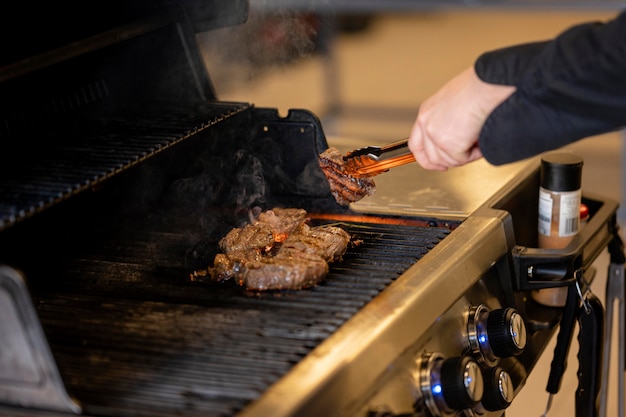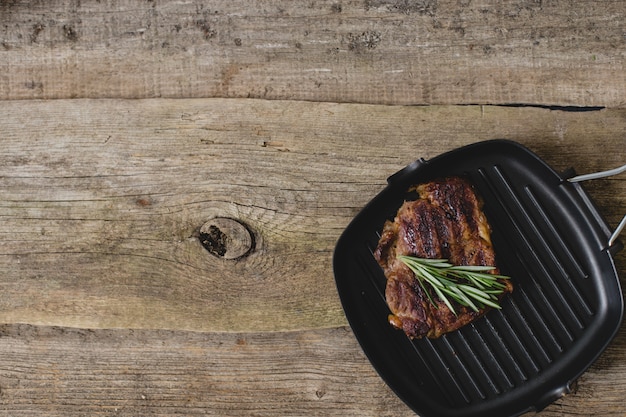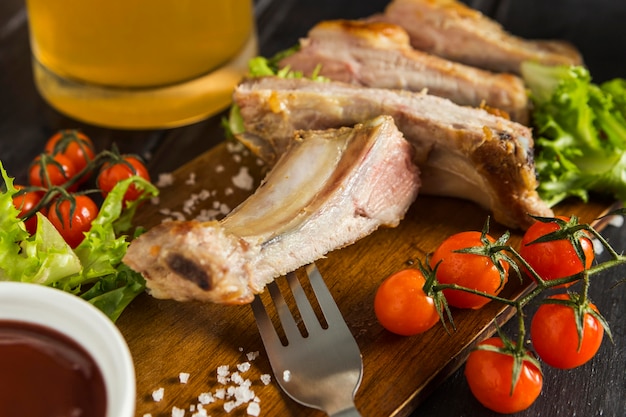There's something truly special about a rib roast. It's a cut of meat that demands attention, a culinary centerpiece that brings people together. But let's be honest, getting a rib roast perfectly cooked can feel like navigating a culinary minefield. Too long in the oven, and you'll be left with a dry, disappointing mess. Undercook it, and you're risking a raw centre. I've been there, trust me. But over the years, I've learned a thing or two about mastering the rib roast, and I'm thrilled to share my secrets with you.
(Part 1) The Rib Roast: A Culinary Star

The rib roast, often referred to as prime rib, is a cut of beef that comes from the rib section of the animal. It's a true culinary star, prized for its rich, decadent flavour, its meltingly tender texture, and its beautiful marbling, which gives it that unparalleled depth of flavour.
The Different Cuts: Choosing Your Star
There are a few different cuts of rib roast available, each with its own personality and culinary potential.
- standing rib roast: The classic, the showstopper. This magnificent cut boasts the bones still attached, making it a dramatic centerpiece for any table. It's the ultimate roast for special occasions, where the carving ceremony adds an element of theatre.
- Rolled Rib Roast: A boneless cut that's been rolled and tied, making it more manageable for both cooking and carving. This is a great option for those who prefer a less traditional approach, or for smaller gatherings.
- Rib Roast with Bone-In: A happy medium, offering the best of both worlds. The bone adds a layer of flavour to the meat, while the boneless portion makes carving a breeze.
(Part 2) The Roast: A Love Story

Choosing the right rib roast is like starting a beautiful love story. You want to find a cut that's not just delicious but also a visual delight. Here's my advice for finding your perfect match:
The Meat: Marbling Matters
Marbling is your rib roast's secret weapon, the key to its juicy tenderness and rich flavour. Think of marbling as tiny pockets of flavour scattered throughout the meat. The more marbling, the more delicious the roast will be. Look for a cut with generous, evenly distributed marbling, a sure sign of a fantastic roast.
The Colour: A Sign of Freshness
The colour of the meat is a tell-tale sign of its freshness. A vibrant red is what you're looking for. Avoid any cuts that look grey or brown, as this could indicate that the meat isn't as fresh as it should be. Freshness is essential for a juicy, flavorful roast.
The Weight: Your Dinner Party Size
Consider your guests. A good rule of thumb is to allow about 1/2 pound of rib roast per person for a standing rib roast, and a bit less for a rolled rib roast. But remember, these are just guidelines. You can always adjust based on your guests' appetites. I've never seen someone turn down a delicious slice of rib roast!
(Part 3) Seasoning: The Flavour Booster

Now, it's time to awaken your rib roast's flavour potential. Seasoning isn't just about adding salt and pepper; it's about creating a symphony of taste. This is where you can really personalize your roast and make it your own.
The Essentials: A Foundation for Flavour
- Salt: Use kosher salt generously, both inside and outside the roast. It draws out moisture and enhances the natural flavour of the beef. Don't be shy – a good amount of salt is your secret weapon.
- Black Pepper: Freshly ground black pepper is a must. It adds a bit of spice and complexity to the flavour profile.
- Garlic Powder: Just a touch of garlic powder adds a subtle but delicious depth to the roast.
- Onion Powder: Onion powder brings a sweet note to the seasoning mix.
The Extras: Adding Depth and Complexity
Here's where you can get creative and add your own signature touch.
- Dried Herbs: Rosemary, thyme, or oregano all pair beautifully with the rich flavour of the rib roast.
- Paprika: A sprinkle of paprika adds a touch of colour and a hint of smokiness to the roast.
- Brown Sugar: A little bit of brown sugar, sprinkled over the roast, creates a delicious caramelized crust.
(Part 4) The Roast: Getting Ready for the Oven
Before your rib roast takes its starring role in the oven, it needs a little preparation. These simple steps will ensure that your roast cooks evenly and achieves that perfect balance of juicy tenderness and a crisp crust.
The Perfect Temperature: Room for Relaxation
Allow the rib roast to come to room temperature before cooking. Remove it from the refrigerator about 30 minutes before you plan to start cooking. This helps it cook more evenly, avoiding any cold spots that could result in uneven cooking.
The Importance of Fat: Letting It Render
If your rib roast is adorned with a thick layer of fat, consider scoring it. This involves making small, shallow cuts across the surface of the fat. Scoring allows the fat to render more evenly during cooking, resulting in a more flavorful and juicy roast. It also helps the seasonings penetrate the meat more deeply.
The Power of Roasting: The Perfect Cooking Method
Roasting is the undisputed champion for cooking rib roasts. It creates a beautiful, golden-brown crust and cooks the meat evenly. The heat surrounds the roast, ensuring that it cooks beautifully from all sides. The temperature and time will vary depending on the size and thickness of your roast, so consult a reliable recipe or chart for guidance.
(Part 5) Cooking Time: Finding the Perfect Balance
Cooking a rib roast is a delicate dance between time and temperature. The goal is to achieve that perfect balance between juicy tenderness and a beautifully crisp crust. The ideal internal temperature for a medium-rare rib roast is 130-135°F (54-57°C), for medium is 140-145°F (60-63°C), and for medium-well is 150-155°F (66-68°C). But remember, everyone's taste is unique, so don't be afraid to adjust based on your preferences.
The Time Factor: A Guide to Cooking Times
Here's a general guideline for cooking times based on the weight of the rib roast:
| Weight (lbs) | Cooking Time (Minutes per lb) |
|---|---|
| 3-4 lbs | 18-20 |
| 5-6 lbs | 15-18 |
| 7-8 lbs | 12-15 |
Remember, these are just starting points. Always use a meat thermometer to check the internal temperature of your roast. This is the most reliable way to ensure that it's cooked to your liking. It's better to err on the side of caution and check the temperature a few times throughout the cooking process.
(Part 6) The Rest: A Crucial Step
Once your rib roast has emerged from the oven, looking beautifully golden and fragrant, don't rush to carve it. It needs a little time to relax and redistribute its juices. This "resting" period is essential for achieving a tender, succulent roast. Allow the roast to rest for 15-20 minutes before carving.
The Importance of Patience: A Culinary Reward
I know it's tempting to dig in immediately, but trust me, the wait is worth it. Resting the roast allows the juices to redistribute throughout the meat, making it incredibly tender and flavorful. This is the moment to grab a glass of wine, put your feet up, and savor the anticipation.
(Part 7) Carving: The Art of the Slice
Carving a rib roast is a bit of a performance, a culinary ballet that demands precision and a steady hand. It's also a chance to showcase the beautiful marbling and the magnificent presentation of your roast.
The Right Equipment: Tools for a Perfect Cut
Start with a sharp carving knife. A dull knife will only make the job more difficult and risk tearing the meat. A carving fork can also be helpful to hold the roast steady while you carve.
The Carving Technique: A Masterful Performance
For a standing rib roast, begin by removing the bones. Cut down along the bone on both sides, then gently lift the rib bones off the roast. You can then carve the roast into individual slices, cutting across the grain of the meat. This will ensure that each slice is tender and easy to chew.
For a rolled rib roast, simply slice the roast into even pieces, cutting across the grain.
(Part 8) Serving: The Grand Finale
The moment has arrived. Your rib roast is ready to take its place on the table, a culinary masterpiece ready to be enjoyed. Here's how to elevate your serving game and make your rib roast the star of the show.
The side dishes: Perfecting the Accompaniment
Pair your rib roast with some classic sides that complement its rich flavour. Think mashed potatoes, creamy Yorkshire pudding, roasted vegetables, or a simple green salad. And of course, no rib roast is complete without a delicious gravy. A good red wine gravy is a personal favourite of mine.
The Presentation: Elevate the Culinary Art
Presentation is everything. Present the roast on a beautiful platter, perhaps garnished with fresh herbs, sliced lemons, or a scattering of rosemary sprigs. This will add a touch of elegance to your meal.
The Atmosphere: Create an Inviting Setting
Create an atmosphere that's as inviting as your rib roast is delicious. Dim the lights, light some candles, and put on some relaxing music. The perfect setting will elevate your enjoyment of the meal and create lasting memories.
FAQs
Here are some common questions about rib roasts and their answers:
1. What's the best way to reheat a rib roast?
The best way to reheat a rib roast is in a low oven, around 300°F (150°C). Wrap the roast tightly in foil and heat it for about 15-20 minutes, until it's heated through. Avoid reheating in the microwave, as this can dry out the meat and leave it tough.
2. Can I freeze a rib roast?
Yes, you can freeze a rib roast. Wrap it tightly in plastic wrap and then foil, and freeze for up to 3 months. To thaw, transfer the roast to the refrigerator for 2-3 days. Don't thaw it at room temperature, as this could encourage bacterial growth. Always thaw in the refrigerator for safety.
3. Can I cook a rib roast in a slow cooker?
While you can technically cook a rib roast in a slow cooker, it's not the ideal method. The slow cooker doesn't get hot enough to properly sear the meat, resulting in a less flavorful and less impressive roast. The high heat of an oven is essential for achieving that beautiful crust and the perfect internal temperature. Stick to roasting in the oven for the best results.
4. What are some good alternatives to a rib roast?
If you're looking for an alternative to a rib roast, try a standing sirloin, a prime rib steak, or a tenderloin roast. These cuts are all known for their tenderness and flavour and can be cooked using similar methods.
5. How can I tell if my rib roast is done?
The best way to tell if your rib roast is done is to use a meat thermometer. Insert the thermometer into the thickest part of the roast, avoiding the bone, and check the temperature. The ideal internal temperature for a medium-rare rib roast is 130-135°F (54-57°C), for medium is 140-145°F (60-63°C), and for medium-well is 150-155°F (66-68°C).
Remember, a perfectly cooked rib roast is a triumph of planning and execution. But with a bit of practice and a healthy dose of confidence, you'll be crafting culinary masterpieces in no time. Happy cooking!
Everyone is watching

How to Cook Frozen Lobster Tails Perfectly: A Step-by-Step Guide
RecipesLobster. Just the word conjures up images of lavish meals, special occasions, and a taste of luxury. But let's...

Pigs in a Blanket Cooking Time: How Long to Bake for Perfect Results
RecipesAh, pigs in a blanket. Just the name conjures up images of those delightful little parcels of crispy pastry en...

Pork Fillet Cooking Time: How Long to Cook It Perfectly
RecipesPork fillet, or tenderloin as it's sometimes called, is a real favourite in our house. It's so versatile, and...

The Ultimate Guide to Cooking Delicious Frankfurters
RecipesLet's face it, we all love a good frankfurter. It's a classic, simple, and always satisfying. But let's be rea...

The Ultimate Guide to Tender, Juicy Pulled Pork
RecipesRight, let's talk pulled pork. It's one of those dishes that just screams "comfort food," doesn't it? I mean...
